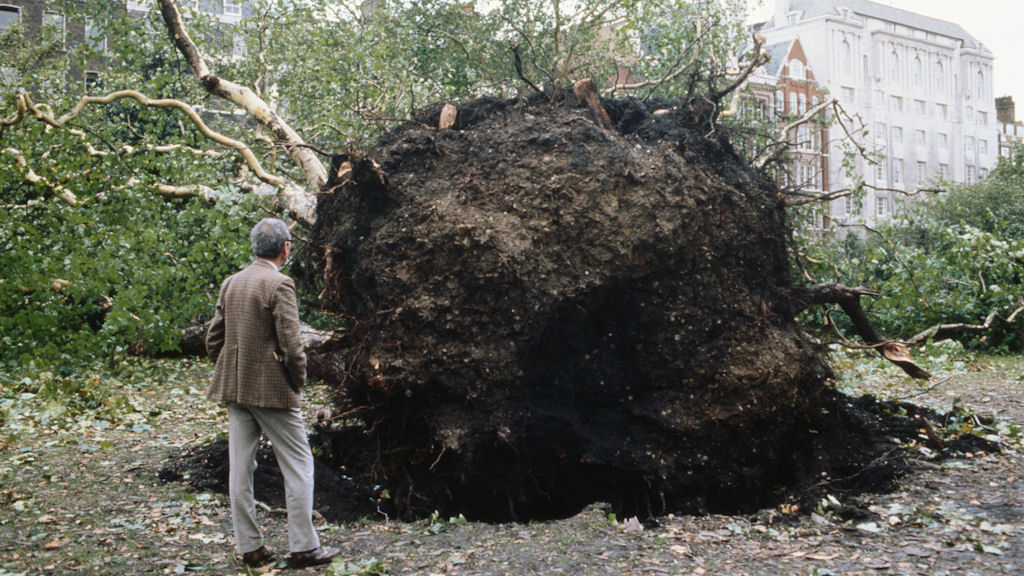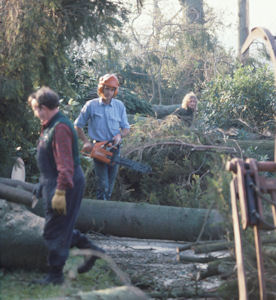How the Great Storm changed the UK’s woodlands
The Great Storm of 1987 dramatically changed the landscape of southern England, but some involved in the environmental recovery process say it transformed our woodlands for the better.

The Great Storm of 1987 was a human tragedy, with 18 lives lost and massive disruption for weeks.
Huge swathes of woodland were lost too, but conservationists and tree experts are reluctant to call it a natural tragedy. Yet in the days following the storm, it did not feel that way to those who had to deal with the millions of trees torn up by winds of up to 100mph.
Andy Jackson, head of Wakehurst Place in Surrey, remembers that first difficult journey into work, the day after the storm.
When he finally managed to negotiate the blocked roads on foot he arrived to discover swathes of trees snapped off near the bottom of their trunks.
He said the unfamiliar scenes created a feeling of dislocation.
“All the landmarks you recognised were gone,” he recalled, speaking to Channel 4 News 25 years on from the storm.
There really was a profound sense of loss. Andy Jackson, head of Wakehurst Place in Surrey
Difficult weeks, months and years followed for the staff at Kew’s country estate, as they carried out the process of clearing up the dead and damaged trees and preparing for the future.
“My view now in hindsight, it was a human grieving process,” said Mr Jackson.
“People go through it at different speeds. Some people had been working there for 25 years. They were the most affected.”
“It seems inappropriate but the emotional connection to trees is very strong,” he added.
“It’s not like losing a person of course, but there really was a profound sense of loss.”
One of the enduring image of the storm’s impact on nature was in Sevenoaks where six of the town’s seven oaks were blown over during the storm – just months later, their replacements were vandalised.
Jill Davison, deputy leader of Sevenoaks council, remembers the storm and the public push to replant trees.
“The district set up a fund called Trees for the Future. I have still got a milk jug with Trees for the Future on the side,” she said.
Rising from the ashes
But just a few years later the shock and sadness in many places had changed to a more philosophical view of the storm. At Wakehurst, once the clean-up operation had taken place, staff began to plan for the future and the guiding force behind these plans was not to repeat the mistakes of the past.
By the early 1990s, a plan had been developed for the estate’s restoration. Gone were the Corsican Pines and Douglas Firs that were planted as quick, cheap timber fodder in the post-war period and vulnerable to the high winds.

In their place were native broadleaf trees like oak, maple and wild cherry, protected by a “shelter belt” of trees selected to withstand the elements.
A third of the storm-hit area of the estate would be replanted over a long period of time with carefully selected native trees, while a further third was harvested and the rest left to regenerate naturally.
“It was profoundly changed. What used to be woodland is now large open spaces,” said Mr Jackson.
This non-interventionists approach was adopted by a number of the big woodland estates around the south of England which were also hit by the storm.
According to the Woodland Trust, overturned trees with a quarter or so of their roots remaining in the ground came into leaf the spring following the Great Storm as though nothing had happened.
At Sheffield Park in Surrey, the storm not only devastated its woodland but destroyed the irrigation system that had allowed the Capability Brown-designed gardens to flourish.
After a failed attempt to recreate the estate as it had been before the storm, it was decided that any new planting should no longer be reliant on having sophisticated irrigation system, so a less ambitious scale of replanting took place.
Gallery: the great storm of 1987 in pictures
Andy Jesson, the head gardener at Sheffield Park told Channel 4 News that important lessons were learned from the storm.
“We learned that what goes on below the ground after a storm is as important as what goes on above the ground. We also learned that we needed to be more proactive in conservation.
“We have six trees that are unique. If they had gone it would have been a loss for everyone. We have tried to locate them in safe places and to propagate the seeds and share them with estates in other parts of the world,” he said.
Replace and regenerate
While Sevenoaks replaced its six destroyed oaks – not once, but twice – the council quickly realised that replacing the hundreds of thousands of trees in the outer areas of the district that had been damaged would be very difficult.
As a result, they left many areas to regenerate naturally.
“It was the only way of doing it,” said Mrs Davison said.
There have been major storms in Britain before – in 1222, 1362, 1662, 1703, 1795 and 1891, but the 1987 tempest is widely regarded as the most severe for 300 years.
Wildlife experts now believe that storms play an important part in our natural environment. The 1987 storm was an opportunity to create new habitats for herbaceous species living in England’s intensely-forested countryside.
Studies suggest that between 1971 and 2001, there was a national reduction in amount of herbaceous species. But the storm-hit south east of England was the only area of the country to buck he trend and see a slight increase.
Mr Jackson puts this down to the storm opening up the canopies.
He said that emotionally, people often have a desire to put something back.
“We were under a lot of pressure from both staff and the public, but it was better to take stock and spend four years thinking of the future of the estate. We now have very detailed plans for what we were going to put in the estate for the next 100 years,” he said.
-
Latest news
-
Diane Abbott row overshadows Labour’s health policy4m

-
Jury deliberating in Trump hush-money case3m

-
Social housing shortage: ‘When I’m 65, if I’m still renting, I can’t retire.’3m

-
What happened when this hotel used to house asylum seekers closed down6m

-
Have governments in England, Wales or Scotland met their house building targets?2m

-




